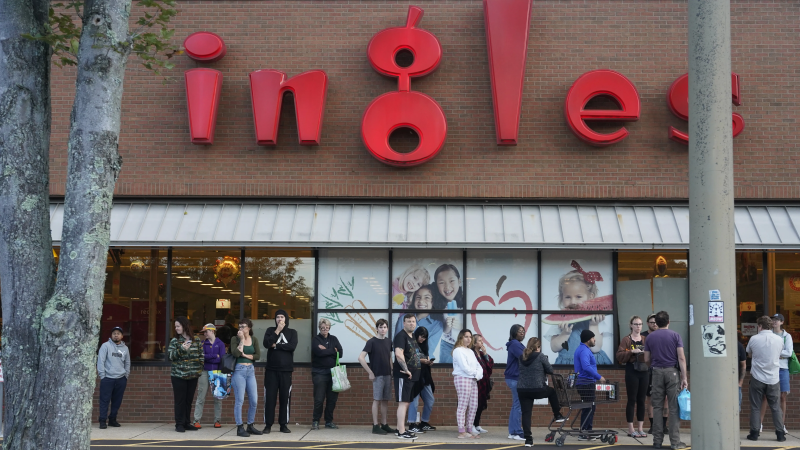'It was really surreal': North Carolina residents watched floods lift cars, buildings
ASHEVILLE, N.C. — As Helene battered western North Carolina, residents in Asheville were heartbroken after seeing floodwaters lift cars, trucks, billboards, and homes.
Syd Yatteau, with her family members Erik and Lana Maystruk, were sheltering in place when the Swannanoa River reached about 26 feet at Biltmore Village on Friday. The next day, Yatteau walked through the mud and debris on South Tunnel Road, where the asphalt had upturned and a massive sinkhole had formed along the washed-out road.
Yattaeu recalled the rapidly rising river as it became a "giant moat" in front of their home, wiping away several houses in their subdivision. Even as the flood waters rose, creeping up the side of a hill and onto their driveway, she said they did not receive an evacuation order. The breadth of damage was unexpected.
"It was really surreal," Yattaeu said of the rapid rise of the Swannanoa River. "Like, at the beginning it was all fun and games. Just watching the water be where it was."
"And then it just kept going up," she said.
Around 4 p.m. Friday, the Swannanoa River hit its peak at 26.1 feet, according to data from the National Oceanic and Atmospheric Administration. That's five feet above the record set during the 1916 floods, which killed numerous people and demolished most of Asheville — including Biltmore Village.
The waters didn't flood Yatteau's home, but they reached a neighbor's home just down the hill. Their neighbors came up and stayed with their family, Erik Maystruk said, then helped them sort through the ruins of their house the day after.
"We tried to go over to their house earlier in the morning today. Tried to salvage as much as we can," Yatteau said.
Hurricanes on repeat:Natural disasters 'don't feel natural anymore'
River brings cars, groceries, houses past local road
Living just down the road from the grocery store Aldi, Yatteau, and the Maystruks watched as the water swept away food from the grocery store. Nearly a half-mile down the road, bags of chips, Snickers, and produce could be found pressed up against the side of the Wood Avenue Bridge.
Near that bridge, the emptied businesses were being picked over by families as they sought to find anything among the wreckage. Drone footage taken by Erik Maystruk showed more of the destructive flooding, including semi-trucks piling up as the river dragged them closer to Biltmore Village.
The day after the catastrophe, the trio made their way up Swannanoa River Road, past a destroyed Walgreens, Lowes Home Improvement, Goodwill, and U-Haul. Trekking through the mud, it took them about 20 to 30 minutes to make it the half mile to South Tunnel Road. While they were supplied with food, water supplies seemed uncertain.
"I don't know about water, but we have a few freezers, so we might be okay," Lana Maystruk said, noting that they did have a backup generator running at their house.
"We don't expect to get power anytime soon," Yatteau said.

Local businesses 'completely destroyed'
Helene wiped out large parts of Asheville, including businesses in the beloved River Arts District. Overlooking the district, the Riverlink Bridge, a central gateway between downtown and West Asheville, has become a sort of hub for gathering as residents reel from the historic damage caused by Helene.
The French Broad River crested at a record 24.67 feet on Friday and was still well above its banks at 12.68 feet on Sunday around noon, according to NOAA.
Bystanders continued to flock to the bridge and were overcome with a sense of serious awe, grief, and horror. Along Depot Street, a car sat empty in the middle of the road with its window open and child seats full of mud had been dragged away.
Just a little bit further down the road, Erin Quevedo, the owner of Balm Salon on Depot Street, was ankle-deep in mud attempting to salvage what she could of her business.
"The salon was completely destroyed. It looks like the water came up to about five feet inside," Quevedo said. Five hair stylists worked at the salon along with her.
"Right now, all we're doing is we're trying to salvage what we can," she said, noting that only a few things, such as hairstyle tools, were salvageable. "A lot of it was underwater."
Inside the salon, the flooding had caused parts of the walls to flake off, as her husband, Ted, bagged hair products and supplies while standing in a thick veil of mud.
"It's really heartbreaking. I'm not really sure what we're gonna do. I think it's just kind of one step at a time," Quevedo said. "I would like to rebuild if I can, but, I mean, it's really hard to say. Like this might be just like a devastating blow to my business, my livelihood."
Will Hofmann is the Growth and Development Reporter for the Asheville Citizen-Times, part of the USA TODAY Network. Got a tip? Email him at WHofmann@citizentimes.com. Consider supporting this type of journalism with a subscription to the Citizen-Times
Disclaimer: The copyright of this article belongs to the original author. Reposting this article is solely for the purpose of information dissemination and does not constitute any investment advice. If there is any infringement, please contact us immediately. We will make corrections or deletions as necessary. Thank you.





